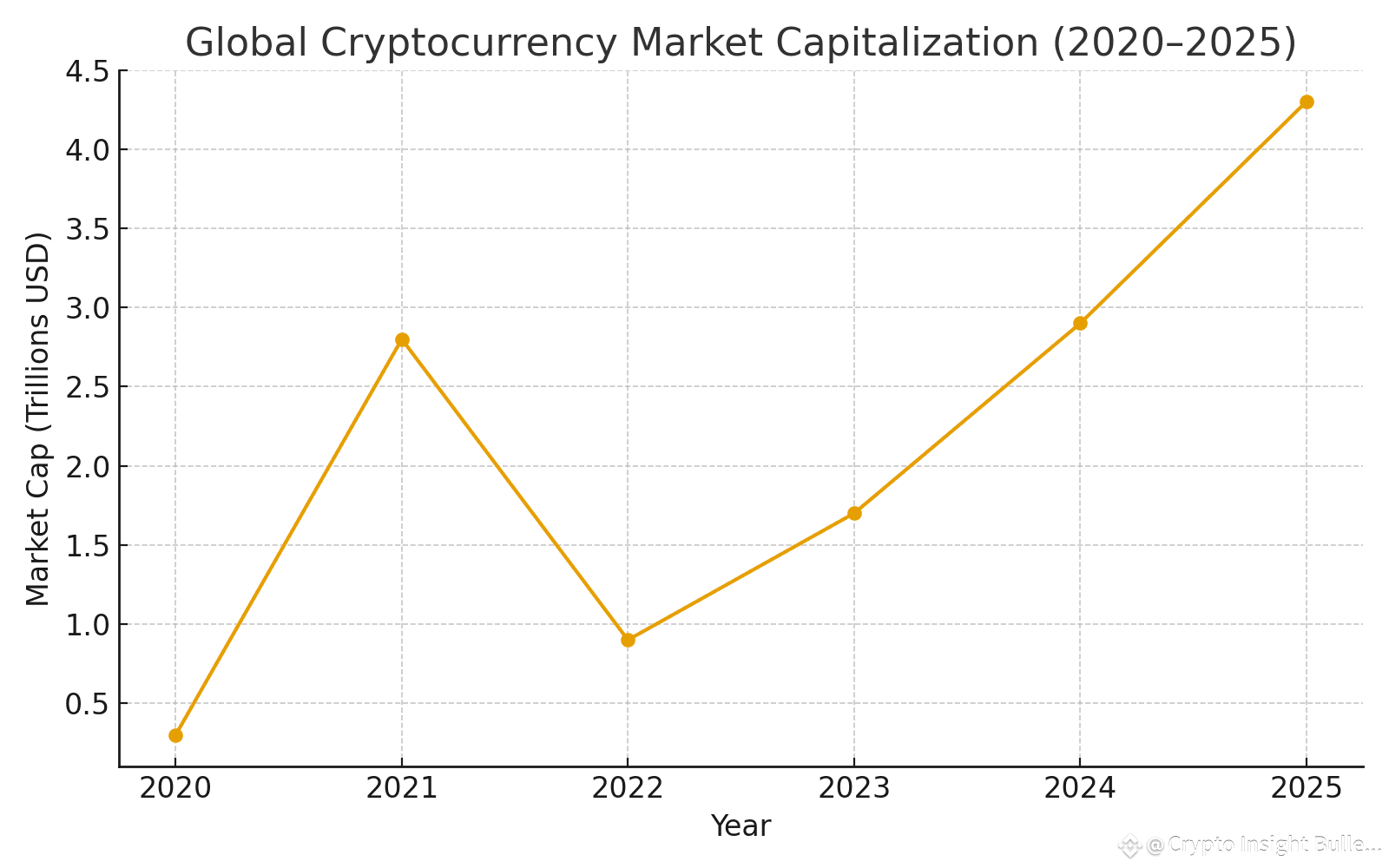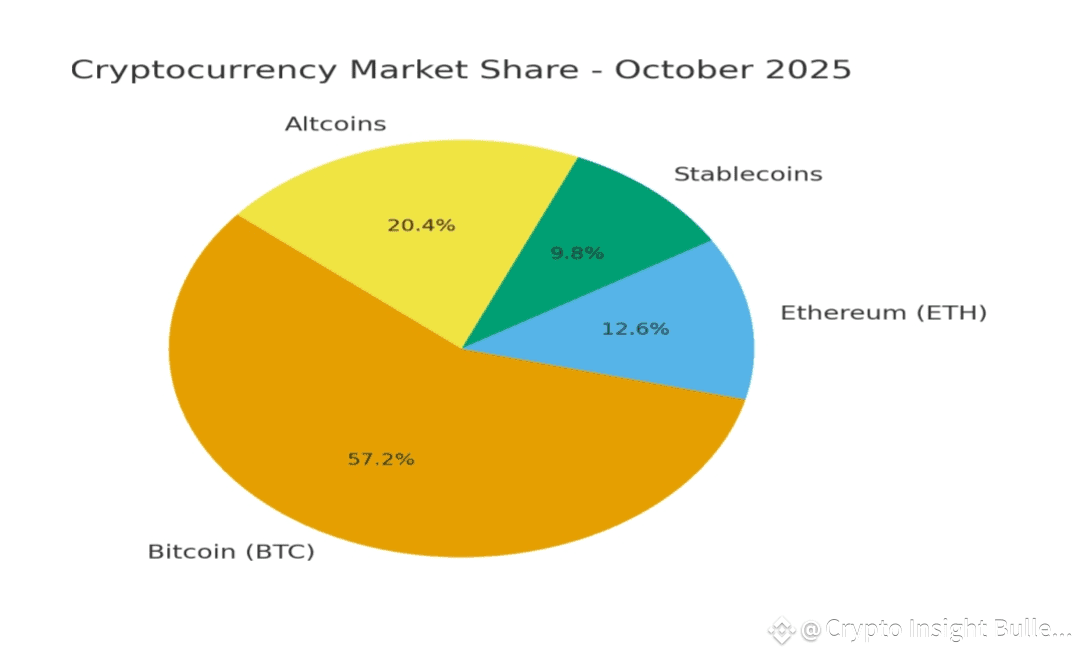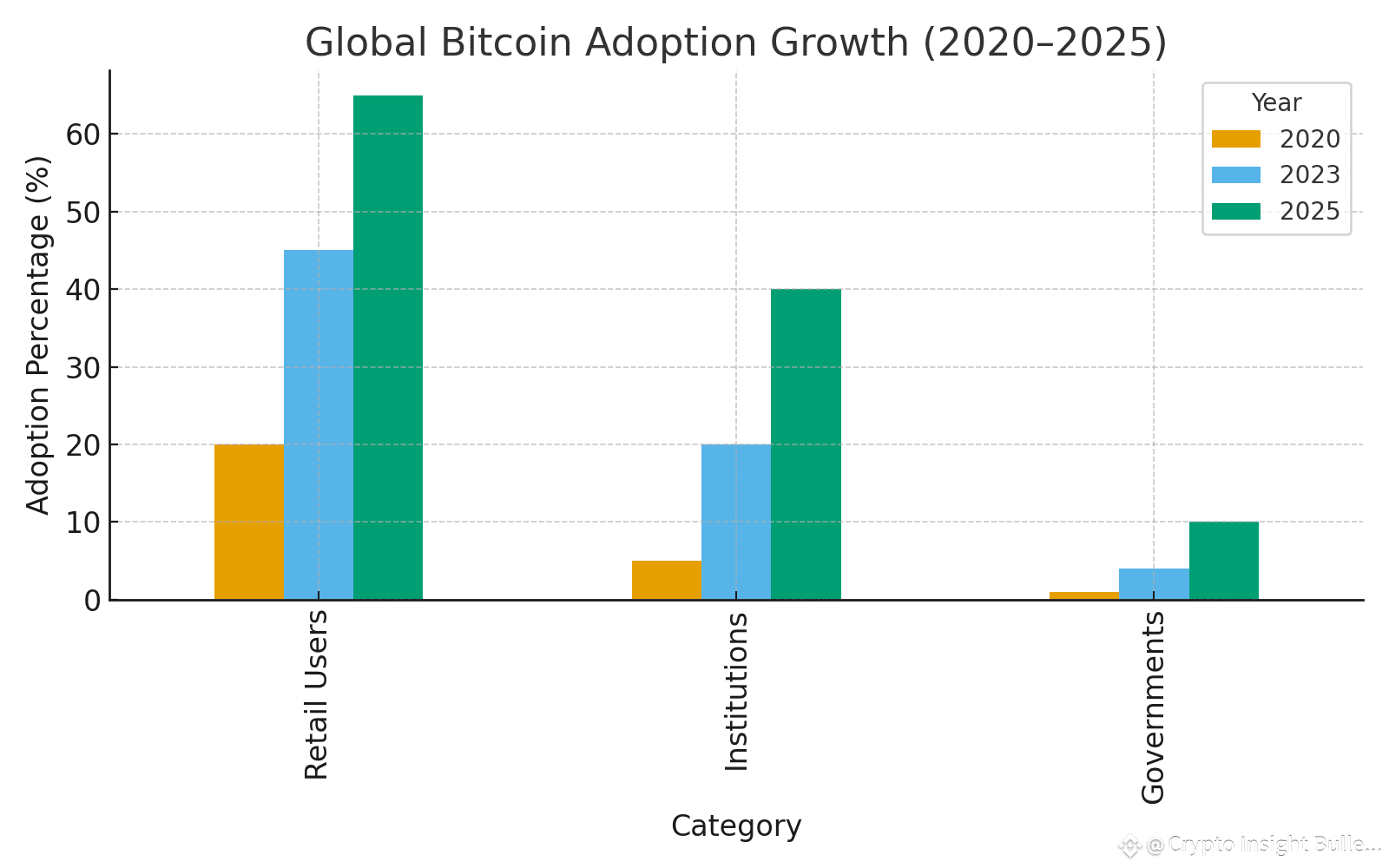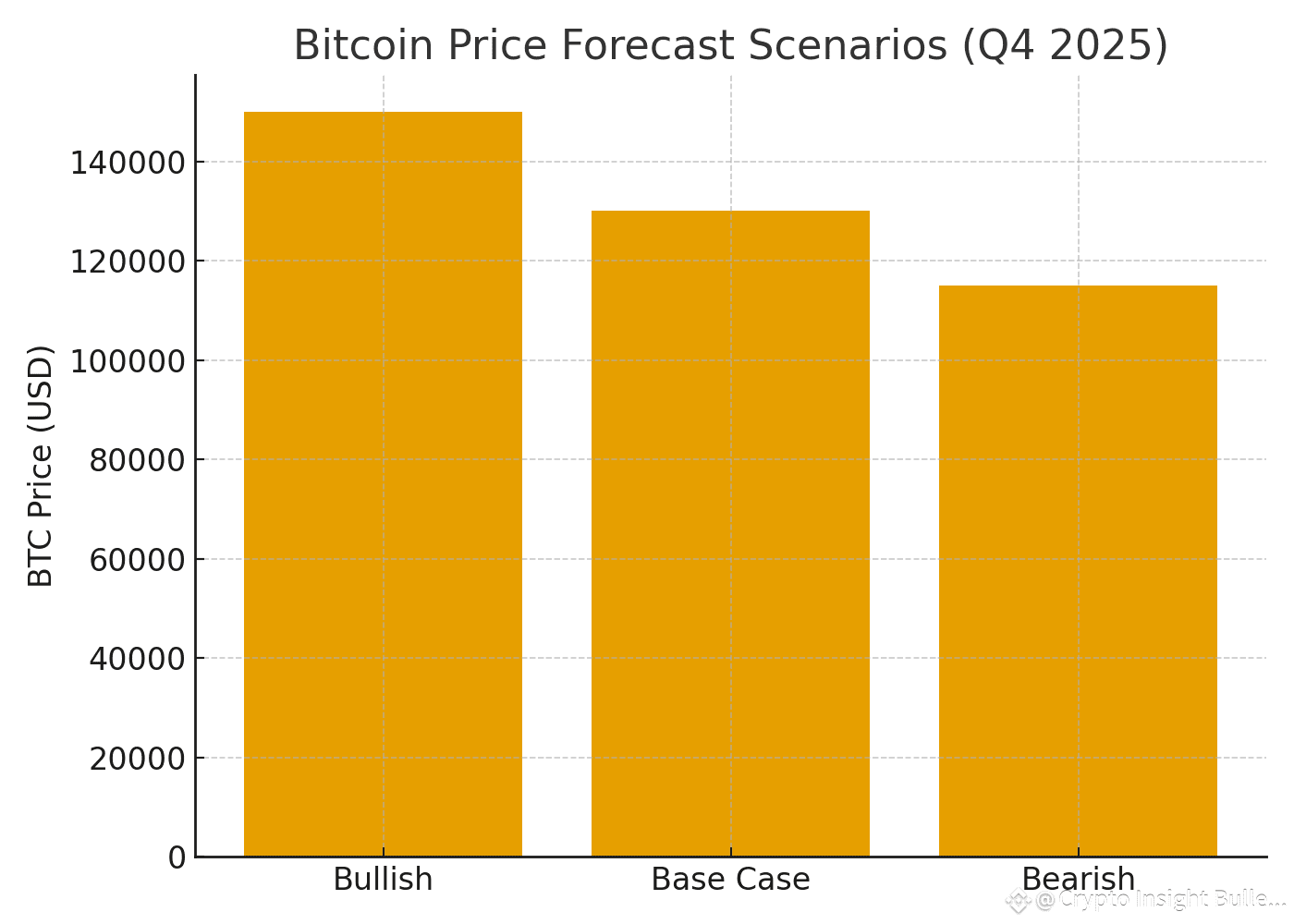On October 5, 2025, Bitcoin (BTC) broke through the $125,500 barrier, which was once thought to be impossible. This is a big step forward for digital money. This is not only a reason for Bitcoin holders to celebrate; it is also a turning point in the growth of the global cryptocurrency economy, which is now worth more than $4.3 trillion.
Bitcoin holds 57.2% of the market right now, while Ethereum (ETH) holds a strong 12.6%. Almost seventy percent of all digital assets are owned by these two companies.
The Big Picture: From Volatility to Global Maturity
The market for cryptocurrencies has come a long way since it was first full of doubt and speculation. What started out as a small experiment with digital money has grown into one of the most important parts of the world's financial system. Between 2020 and 2025, the total value of all cryptocurrencies on the market grew by an incredible 1,300%, from $300 billion to more than $4.3 trillion.
There have been big changes in this growth, like the big bull run in 2021, the big drop in 2022 because people were worried about global inflation, and the big rise that started in 2024 because institutions were confident, there were clear rules, and Bitcoin's most recent halving event.
Institutional Confidence: The Engine Behind the Surge
This new Bitcoin bull market is different from the ones that came before it because it is not being driven by retail investors. Instead, institutional investors are the ones who are driving it. Some of the big financial companies that have started Bitcoin ETFs are BlackRock, Fidelity, and ARK Invest. These ETFs make it safe for regular people to invest in the market.
Sovereign wealth funds from places like Singapore and the United Arab Emirates have also said publicly that they have put 1% to 2% of their national reserves into Bitcoin and other digital assets. Bitcoin is no longer just a speculative token; pension funds, insurance companies, and hedge funds now see it as a strategic macro hedge. It works like gold in the 21st century, but it's digital.
This wave of institutions has had a big effect on Bitcoin's liquidity. Exchange reserves are at their lowest level in five years because more BTC is being held in long-term custody and ETFs. This supply shock, along with steady inflows of money, has caused the price of Bitcoin to rise, which is a classic example of scarcity economics.
The Halving Effect: Supply Tightens, Demand Explodes
The market is still moving because of the Bitcoin halving event in 2024, which cut block rewards from 6.25 BTC to 3.125 BTC. This event happens every four years and slows down the rate at which new Bitcoin is made available, which makes it seem like there is less of it. This time, the halving happened when there was more institutional demand, which created a perfect storm of low supply and high interest.
After the halving, this led to the biggest rally in Bitcoin's history. Experts say that the annual inflation rate of Bitcoin's supply has dropped below 1.7%. This is a lot lower than the inflation rates of gold and most fiat currencies.
Ethereum and the Broader Ecosystem
Bitcoin is still the most popular cryptocurrency, but Ethereum is now the second most important one in the crypto economy. It has a 12.6% share of the market because many people use it for smart contracts, NFTs, and decentralized finance (DeFi). People are even more sure that the Ethereum network can grow and is good for the environment after the recent "Verde" upgrade.
Ethereum is the next step in digital finance because it uses less energy and can handle more transactions. There are other digital assets besides Bitcoin and Ethereum that have become popular in their own right. Stablecoins and altcoins that are made for a certain purpose are two examples.
Stablecoins make up almost 10% of the whole market. They are an important link between decentralized systems and regular finance.
Global Impact: From Wall Street to Main Street
Bitcoin's rise isn't just on trading charts; it's changing economies and societies all over the world. El Salvador was the first country to make Bitcoin legal tender, and it is still benefiting from its bold move. Bitcoin bonds have brought in more than $3 billion in foreign investment.
In the meantime, Singapore, Switzerland, and Hong Kong have become major crypto centers by using clear rules to draw in new fintech companies. Bitcoin use for sending money across borders has skyrocketed in Latin America and Africa. It costs more than 70% less than using traditional banks.

Recent studies show that 65% of retailers have adopted it, and institutional participation has grown four times since 2020. Some governments are even trying out Bitcoin-based settlement systems and blockchain-powered national payment systems.
Macroeconomic Factors: The Winds Behind Bitcoin’s Rise
Bitcoin is now worth $125,500, which is another sign that the world's macroeconomic trends are changing. As inflation slows down and central banks lower interest rates, investors are once again looking for safe places to put their money and things that will help it grow. It's a good choice because there isn't a lot of Bitcoin and you can use it anywhere.
The industry really needs clearer rules to make it more legitimate, which is what they have done. The EU's MiCA framework and the US's Digital Asset Regulation Act of 2025 have made people less worried about the law. This has made more money come in. This new level of clarity has turned Bitcoin from a "unclear" asset into a well-known part of modern finance.
The Road Ahead: Predictions and Possibilities:
What does the future hold for Bitcoin now that it has reached this all-time high? People have different ideas, but most people are cautiously optimistic. If Bitcoin keeps growing at the same rate as it has been, many analysts think it could be worth between $135,000 and $150,000 by the end of 2025.
Optimists see signs of long-term growth in the growing role of Bitcoin in cross-border finance, the growing number of ETFs, and the growing use of Bitcoin by companies. But pessimists warn that taking profits and stricter rules in some markets could cause short-term corrections.

There are risks, but one thing is clear: Bitcoin has been tested and proven to be strong over and over again. Every bear market has made its infrastructure stronger, from energy-efficient mining to advanced security protocols and institutional-grade custody solutions.
Voices from the Industry
People who know a lot about money are saying that this is a key moment in Bitcoin's growth. "
This isn't a speculative mania; it's a shift of money to a new asset class." Elena Ruiz, Chief Economist at FinEdge Analytics, says, "Bitcoin is now part of the global financial architecture.
" Lars Chen, Director of Blockchain Strategy at Arcadium Capital, says, "Ethereum's continued relevance despite Bitcoin's dominance shows that the crypto ecosystem is growing and changing."
These points of view make a very important point: what we're seeing is not just a rise in prices, but a change in the way value is stored, moved, and trusted around the world.
Conclusion: The Dawn of the Institutional Era
Bitcoin's rise above $125,500 marks the start of a new era in digital finance: the Institutional Era. The skeptics who thought it was just a passing trend now have to deal with a market that has grown beyond its speculative beginnings and become a trillion-dollar force that will shape the future of money.
Bitcoin has made its way into every part of finance, from Wall Street ETFs to blockchain projects backed by the government. Volatility may go down as it gets older, but its importance will only grow.
What started out as a way to get away from central banks has now turned into the basis for a new financial system: an economy that is open to everyone, not run by a single government, and based on trust, scarcity, and innovation.
In 2015, Bitcoin was a gamble.
In 2020, it was an investment.
In 2025, it has become a strategy
and perhaps, the future of global finance.
#BTCBreaksATH #MarketUptober #USGovShutdown #SECTokenizedStocksPlan #InsightBulletin $BTC


